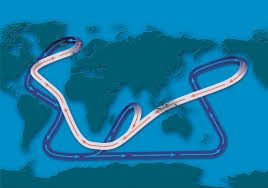I am not an oil engineer, I am an Environmental Chemist, and I have yet here for any of the BP or USA engineers to state the larger issue then the Gulf being coated with oil, though that is bad enough. The larger issue is the oil which is enterning the gulf stream, the current which is part of the interocean beltway.

If this oil spill continues, which I am sure it will, the tropical storms will churn the gulf, and this great oil spill will begin to spread, world wide, killing the phytoplankton as it spreads. Phytoplankton, first of all food webs, and more important, produces 80% - 90% of the Oxygen for EARTH. All environmentalists understand that if the PHYTOPLANKTON DIES, humans have 6 month to a year to live.
So, the engineers of BP are not working to save birds and fish in the gulf, but now after 7-8 weeks, need to think of the 6.5 billion humans!
http://www.technologyreview.com/blog/guest/25303/?ref=rss
BP's Leaky Spill Cap: Better Than It Looks?
Credit: BP. |
BP claims to be sucking crude straight off its stricken mile-deep wellhead and pouring it into the drillship Enterprise at a rate of 11,000 barrels per day, thanks to a cap and tube installed on Friday. And, yet, video feeds from ROVs present a plume of oil and gas gushing out into the depths that looks as angry as ever--more black goop destined for dispersal into the Gulf of Mexico's already beleaguered ecosystems.
"Clearly alot of people are looking at it and trying to understand what does this mean," acknowledged BP senior vp/exploration Kent Wells of the top-rated video images during in a media briefing yesterday.
Wells couldn't say how much oil is escaping but he took pains to remind viewers that the leak is now pouring around their 4-foot-wide steel LMRP cap, making the plume appear wider. "It's easy to forget that there's a big vessel inside that," says Wells. And it's certainly true that his engineers might be capturing the bulk of the flow, according to the federal flow estimates released last month. The two independent federal models of the flow both said the flow could as low as 12,000 barrels per day (bpd).
Unfortunately the federal models also provided plenty of headroom, saying the flow could be as high as 19,000 bpd in one case, and 25,000 bpd in the other. And the modelers predicted the flow might accelerate as much as 20% when BP cut away the riser from the sunken Deepwater Horizon platform, as required to install the cap. In other words BP's cap could be capturing barely one-third of the flow.
A better cap is to be installed by the end of June, according to Wells. Whereas the existing cap simply pushing a rubber grommet down on to flange on the BOP, he says BP engineers and government scientists are working on three new designs that could reach around and hook onto the flange.
But Wells admitted that optimization of the oil containment effort today could give way to new disasters later this summer with the arrival of hurricane season, which usually begins menacing the Gulf in August. If a storm blows across the leak site BP will have to disconnect the drill ships collecting oil, keeping the ships and their crews safe but throwing the Gulf ecosystem back to the dogs.
Wells says the new cap they plan to install later this month is part of a system that will allow quicker disconnects and reconnects, minimizing the time without containment. But he's not prepared to say that the cap could actually seal off the flow until the storm had passed "I wouldn't want to say yet that we'd have the ability to close it off when we disconnect," says Wells. "We're just not there yet."









No comments:
Post a Comment